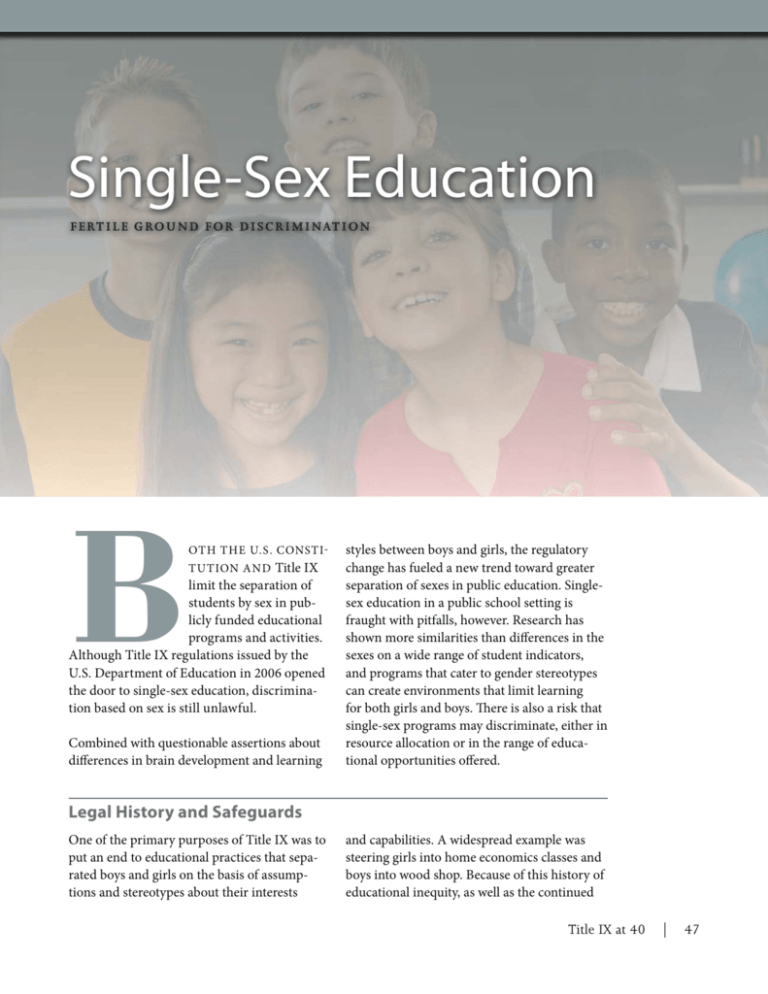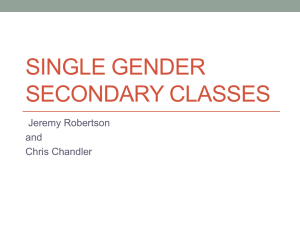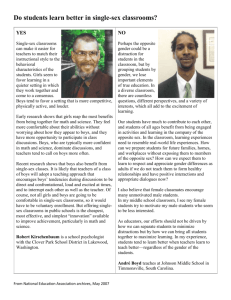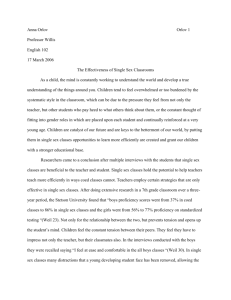Single-Sex Education - Feminist Majority Foundation
advertisement

Single-Sex Education F E RT I L E G RO U N D F O R D I S C R I M I NAT I O N B OTH THE U.S. CONSTITUTION AND Title IX limit the separation of students by sex in publicly funded educational programs and activities. Although Title IX regulations issued by the U.S. Department of Education in 2006 opened the door to single-sex education, discrimination based on sex is still unlawful. Combined with questionable assertions about differences in brain development and learning styles between boys and girls, the regulatory change has fueled a new trend toward greater separation of sexes in public education. Singlesex education in a public school setting is fraught with pitfalls, however. Research has shown more similarities than differences in the sexes on a wide range of student indicators, and programs that cater to gender stereotypes can create environments that limit learning for both girls and boys. There is also a risk that single-sex programs may discriminate, either in resource allocation or in the range of educational opportunities offered. Legal History and Safeguards One of the primary purposes of Title IX was to put an end to educational practices that separated boys and girls on the basis of assumptions and stereotypes about their interests and capabilities. A widespread example was steering girls into home economics classes and boys into wood shop. Because of this history of educational inequity, as well as the continued Title IX at 40 | 47 KEY FINDINGS 1. In recent years, there has been a growing trend of separating students on the basis of sex. This trend raises serious equality and policy concerns, and may violate numerous provisions of state and federal law. 2. In public schools, the circumstances under which students can be separated by sex are limited by the Constitution and Title IX. Although the U.S. Department PG&EVDBUJPOMPPTFOFESFTUSJDUJPOTJOTDIPPMTNVTU still meet a host of legal requirements before separating students by sex. Few meet these safeguards. 3. Many single-sex programs claiming a basis in research are in fact based on claims that amount to little more than repackaged sex stereotypes—for instance, that boys need authority and excel at abstract thinking, while girls need quiet environments that focus on cooperation and following directions. 4. In the classroom, separating boys and girls can reinforce stereotypes in ways that are stigmatizing and damaging to both groups. Moreover, single-sex programs can discriminate against one group in allocating resources or educational opportunities. 5. Despite assertions to the contrary, separating students by sex has not been proven to improve educational outcomes. Evaluations generally fail to compare single-sex programs with comparable coed programs or to control for other factors that affect outcomes, such as class size and student ability. 6. The weaker 2006 regulations have opened the door to discrimination. The Department of Education should rescind these regulations and clarify what is and is not permissible to help put an end to inequitable programs. risk of sex stereotyping, both Title IX and the U.S. Constitution include safeguards to ensure that educational programs that classify students on the basis of sex are not discriminatory. Although it permits some single-sex schools, Title IX prohibits separation of boys and girls within coeducational schools except under certain narrow circumstances. Moreover, the 48 | Title IX at 40 Constitution requires that any gender-based classification (whether in a coeducational school or a single-sex school) have an “exceedingly persuasive justification,” and be “substantially related” to an important governmental objective.1 The Supreme Court has limited when sex classifications are justified, noting that such classifications must be “determined through reasoned analysis rather than through the mechanical application of traditional, often inaccurate, assumptions about the proper roles of men and women,” and has further clarified that “overbroad stereotypes” about the typical talents, capacities, and preferences of men and women are an impermissible basis for separation of the sexes.2 In 2002, spurred by provisions in the education reform law known as No Child Left Behind that permitted funding of “innovative” programs— including single-sex education “consistent with applicable law”3 —the Department of Education issued a notice that it intended to relax regulatory restrictions. The Department commissioned a study to survey existing research on the efficacy of single-sex education, which found that research on single-sex schools generally failed to meet accepted standards in terms of research design and methodology. The study ultimately concluded that the results of even the better-designed studies were “equivocal.” Moreover, the Department received overwhelming objections from a diverse coalition of advocates for equality in education to its 2004 proposed regulations, which allowed more flexibility in the use of single-sex education. Nonetheless, in 2006, the Department of Education issued Title IX regulations that eased previous regulatory restrictions significantly. Under the 2006 regulations, schools can exclude boys or girls from classrooms on the basis of vague goals such as “improving the educational achievement of students” by offering “diverse educational options,” “provided that the single-sex nature of the class or extracurricular activity is substantially related to achieving that objective.” Few schools have attempted to—or could—demonstrate that superior student achievement is substantially related to sex separation. The regulations also authorize schools to conduct their own evaluations of programs, with no outside monitoring or guidance on how evaluations should be conducted. The result has been a de facto slackening of standards and an increase in discriminatory practices that harm both boys and girls. Claims about Sex Separation The “reasoned analysis” for single-sex programs called for by the Supreme Court is often notably absent from the rationale for separate programs, particularly when scientific claims are examined carefully. Many single-sex programs started since the 2006 regulation change are based on the notion that boys’ and girls’ brains are so fundamentally different that they need to be taught not only separately but also using different methods, even though neuroscientists and experts in child development and education have discredited these assertions. Rather than sound science, such conclusions often rest on stereotypes about the interests and abilities of boys and girls.4 PURPORTED GENDER DIFFERENCES Advocates for single-sex education often argue that separation by sex is necessary because of purported hard-wired differences in the brains of girls and boys. In his book Why Gender Matters,5 Leonard Sax—a physician and psychologist who founded the National Association for Single Sex Public Education and runs teacher training sessions nationally—makes these claims, among others: t (JSMTIFBSJOHJTGBSNPSFTFOTJUJWFUIBOCPZT so teachers should speak softly to girls but yell at boys. blood to rush to boys’ brains, thus priming them to learn. t #PZTTIPVMESFDFJWFTUSJDUBVUIPSJUBSJBOEJTcipline and respond best to power assertion. Boys may be spanked, while girls may not. t "CPZXIPMJLFTUPSFBEEPFTOPUFOKPZDPOtact sports, and does not have a lot of close male friends should be firmly disciplined, required to spend time with “normal males,” and made to play sports. Michael Gurian, author and founder of the Gurian Institute, which also trains teachers, propounds similar theories. For instance, according to Gurian:6 t #PZTBSFCFUUFSUIBOHJSMTJONBUICFDBVTF their bodies receive daily surges of testosterone, while girls have equivalent mathematics skills only during the few days in their menstrual cycle when they have an estrogen surge. t #PZTBSFCZOBUVSFBCTUSBDUUIJOLFSTBOETP are naturally good at things like philosophy and engineering, while girls are by nature concrete thinkers. t 'VMMGFNBMFQBSUJDJQBUJPOJOBUIMFUJDTJTOPU “neurologically or hormonally realistic.” t 8IFOHJSMTBSFVOEFSTUSFTTCMPPESVTIFT away from their brains, while stress causes Title IX at 40 | 49 DEBUNKING ASSUMPTIONS While these assertions are presented as recent scientific discoveries, they have been overwhelmingly debunked by reputable scientists. For example, the Association for Psychological Science recently selected six independent cognitive experts to examine sex differences in learning math and science. These experts concluded, “None of the data regarding brain structure or function suggests that girls and boys learn differently or that either sex would benefit from single-sex schools.”7 far more within groups of boys or girls than between the average boy and girl.”9 Psychologist Janet Shibley Hyde, another recognized expert on gender differences and similarities, concludes that the available data suggest that the sexes are far more similar than different in terms of cognition. She further states, “Educators should be wary of arguments for single-sex education that rest on assumptions of large psychological differences between boys and girls. These assumptions are not supported by data.”10 A 2011 Science article by the American Council for Coeducational Schooling researchers, “The Pseudoscience of Single-Sex Schooling,” concluded that singlesex education “is deeply misguided, and often justified by weak, cherry-picked, or misconstrued scientific claims rather than by valid scientific evidence.”11 E V I D E N C E - B A S E D CO N C LU S I O N S Although there is no doubt that some singlesex education programs have enjoyed successful outcomes, no rigorous studies have linked their successes to the single-sex structure rather than to other factors.12 For example, studies that have claimed to demonstrate a causal relationship between the single-sex structure and improved outcomes have failed to control for variables such as class size, socioeconomic status, or student ability. Other research abounds. A research review conducted at the time of the 2006 regulation changes found that half a century of research across Western countries has not shown any dramatic or consistent advantages for singlesex education for boys or girls.8 Neuroscientist and Chicago Medical School professor Lise Eliot, who recently published a book exploring gender differences and their biological and social causes, concludes, “the argument that boys and girls need different educational experiences because ‘their brains are different’ is patently absurd. The same goes for arguments based on cognitive abilities, which differ 50 | Title IX at 40 Separating boys and girls based on sex stereotyping is not only unlawful but also potentially harmful. Assuming, for instance, that boys need active, loud environments focused on abstract thinking skills and girls need quiet activities that emphasize concrete thinking makes it less likely that the classroom will meet the varying learning needs of all students. Teaching to these stereotypes limits opportunities for both boys and girls and keeps both from learning the full range of skills necessary for future success in school, work, and life. How Sex Separation Plays Out in the Classroom Most single-sex programs in public education started after 2000. By 2008–2009, there were more than 1,000 coeducational public schools that included at least some single-sex programming at the K-12 level, including academic classes. It is estimated that today there are more than 100 all-girl or all-boy public schools, including public charter and magnet schools. The Department of Education’s Civil Rights Data Collection of 2010 indicates that more single-sex academic classes in coed public schools exist for boys than for girls.13 Below are examples of programs that either flout the spirit of or outright fail to comply with the legal standards set forth in Title IX, the Constitution, and the 2006 Department of Education regulations. These programs often reinforce gender stereotypes, fail to offer comparable subjects for boys and girls, provide no comparable option for students who prefer coeducation, or allocate fewer resources for girls’ programs. Greater accountability, including monitoring for compliance with regulations, is needed to end such discriminatory practices. R E I N F O R C I N G G E N D E R S T E R E OT Y P E S Press accounts, public records requests, and litigation surrounding single-sex programs provide strong evidence that fears about the impact of relaxing the Title IX regulations are well founded. Many school administrators around the country have latched onto the notion that teachers should provide very different classroom experiences for boys and girls. Often this approach results in forcing boys and girls into gender stereotypes that serve neither group. For example, boys-only classes often focus on sports and leadership themes, while girls-only programs teach manners and cooperation. Voices Against Discrimination i4FHSFHBUJOHCPZTBOEHJSMTEJEOUNBLFUIJOHTBOZCFUUFSGPS our children. In fact they made things worse. Our kids were basically being taught ideas about gender that come from the Dark Ages.” —Parent of middle school child in a single-sex program, Mobile, Alabama “A loud, cold classroom where you toss balls around…might be great for some boys, and for some girls, but for some boys, it would be living hell.” —Diane F. Halpern, professor of psychology, Claremont McKenna College “My fears were realized when I found out that the whole idea behind separating the girls from the boys was the notion that they needed to be taught using different teaching TUZMFTBOEFWFODVSSJDVMB*OUIFHJSMTDMBTTFTUIFZXFSF BTTJHOFECPPLTBCPVUSPNBODFBOEJOUIFCPZTDMBTTFT they were reading books about hunting and dogs. My second daughter had another three years at the school, and I DPVMEOUGBDFUIFJEFBPGIFSHFUUJOHUISFFNPSFZFBSTPGUIBU kind of conditioning. The biggest lesson I hope my girls learn from this experience is that they can be vocal, strong, and independent, and they EPOUOFFEUPCFDPEEMFEPSTQPLFOTPGUMZUPJOPSEFSUP accomplish anything they want to in life.” —Parent who successfully challenged single-sex programming in a Louisiana public middle school Information for these examples and those in the following sections comes mostly from press reports, as there is often little public oversight or debate regarding the initiation of these programs, and few schools even indicate publicly that they operate sex-separated classes. t "TJOHMFTFYLJOEFSHBSUFOQSPHSBNJO1JUUTburgh taught boys vocabulary using basketball and relay races, while teachers read girls stories about fairies and princesses and used wands and tiaras as learning incentives.14 Title IX at 40 | 51 t *OTJOHMFTFYĕSTUHSBEFDMBTTFTBUBDIBSUFS school in Lansing, Michigan, boys drew monsters and played games with balls, while girls had tea parties to teach social skills and manners.15 t "TJOHMFTFYNJEEMFTDIPPMJO4PVUI$BSPMJOB allowed boys to move around the classroom and toss a ball to determine whose turn it was to talk, while girls raised their hands to talk in a room that smelled like flowers, and “were taught to cooperate in different ways.”16 t 4UBSUJOHJOoBMMTJYUIHSBEFNBUI science, and humanities courses were separated by sex at a middle school in Tacoma, Washington. Boys played catch to help learn multiplication, while girls could “do what girls do: talk at great length about their subjects.” The principal said the school would offer a coed option only if “enough” parents requested it.17 t "8JTDPOTJOTVQFSJOUFOEFOUKVTUJĕFEBQMBO to create single-sex high school science classes based on “research data” showing that boys like “creative hands-on projects that culminate in something with a different level of understanding,’” while girls followed directions and “may not even understand what happened in the science lab, but they got the right answers.”18 F R O M S T E R E OT Y P E S TO D I S C R I M I N AT I O N When sex stereotypes guide educational programming, discrimination follows. Singlesex programs in the public school setting that are demonstrably inequitable fail to comply with Title IX, even under the 2006 regulations. These programs may be challenged for practices that violate students’ civil rights, such as involuntary assignment to single-sex classrooms, failure to provide coeducational options in addition to the single-sex classes, and inequitable use of resources. Recognizing the problems associated with this programming, including reliance on sex ste- 52 | Title IX at 40 reotypes, some schools or districts have chosen to discontinue their single-sex programming. Following are two examples of single-sex programs that were successfully challenged. Proposed high school conversion from coed to dual academies, Pittsburgh, PA. After two of the district’s high schools, Westinghouse and Peabody, were designated for corrective action under No Child Left Behind, the school board approved a proposal to close the Westinghouse grade 9–12 program and open in the same location the Young Men’s and Young Women’s Academies, to serve grades 6–12. The academies were scheduled to open in the 2011–2012 school year. The program, which was piloted the previous year in several classrooms at another public high school, was structured as two single-sex academies to cater to “the separate needs of young women and young men.”19 However, the school board failed to produce or cite any data tracking the outcomes of the pilot program. Information about the academies, received through an open records act request filed by the American Civil Liberties Union (ACLU) of Pennsylvania, claimed that “research solidly indicates that boys and girls learn differently,” including that “adolescent girls’ brains exhibit high levels of communication between different subject matter, cultures and time periods, while young men make meaning through movement,”21 although no such research was cited. The academies were to offer a longer school day and were intended to have a more rigorous academic focus. The program offered boys— but not girls—access to a summer program to improve their readiness for the academic programs at the new academies. The plan called for students to be assigned to one of the single-sex academies, giving parents a limited time to opt out. The program was abandoned in fall 2011 after the ACLU threatened to file a complaint with the Office for Civil Rights (OCR). Middle school separation of boys and girls, Mobile County, AL. In 2009 the Mobile County Public School System implemented single-sex programs in eight middle schools without notifying parents. At one school, boys and girls ate lunch at different times and were not allowed to speak to each other on school grounds.22 For boys, teachers were instructed to create “competitive, high-energy classrooms” and teach “heroic behavior”; for girls, to create “cooperative, quiet classrooms” focusing on “good character.” In sixth-grade language arts, boys were told to brainstorm action words used in sports, while girls were told to describe their dream wedding cake. “Electives” were pre-assigned: girls took drama and boys took computer applications, with no option for changing classes. The principal told parents that “boys’ and girls’ brains were so different they needed a different curriculum.” The program was terminated shortly after it began in all eight schools after the ACLU threatened a lawsuit on behalf of two parents. The Challenge of Evaluation In addition to the flawed scientific rationale for single-sex education, lack of sound evaluation of single-sex programs is an ongoing problem. In particular, studies claiming positive results generally do not have comparable control groups in coed programs, making it impossible to draw meaningful comparisons. Where they do draw comparisons, they generally fail to control for school and student variables known to affect academic outcomes. A typical example is an evaluation conducted in South Carolina. In November 2010, the South Carolina Department of Education released a survey of parents, teachers, and students participating in single-gender classes.23 Its methodological flaws included having no control group of students in coed classes; asking questions likely to lead to a positive answer; and failing to take into account the self-fulfilling expectations of parents, teachers, and students who had selected single-gender classes. It did not compare actual student performance of boys and girls or of students in single-sex classes with comparable students in coed classes.24 The South Carolina Department of Education justified its inadequate review of the effectiveness of single-sex classes by saying that it interpreted the Department of Education’s 2006 regulation this way: “Federal law only requires schools to ‘review’ their data every two years, not to report it. As such, there is no requirement for any school to publish or communicate the impact of their single-gender program.” It is perhaps notable that South Carolina has since significantly reduced funding for its Office of Single-Gender Programs and has removed the 2010 survey from its website. NCWGE Recommendations t ćF64%FQBSUNFOUPG&EVDBUJPOTIPVME rescind its 2006 changes to the Title IX regulations, which loosened restrictions on single-sex education, and clarify what is and is not permissible. t 'FEFSBMHVJEFMJOFTTIPVMEJODSFBTFBDDPVOUability and transparency by requiring reporting of single-sex programs and their evaluations on public websites. Schools should also be required to disclose and provide public access to program data. t ćF%FQBSUNFOUPG&EVDBUJPOTUBUFFEVDBtion agencies, school boards, and school administrators (including Title IX coordinators) should improve monitoring and enforcement of Title IX compliance to Title IX at 40 | 53 prevent discriminatory practices that hinder learning and limit equal opportunities. t 'FEFSBMBOETUBUFFEVDBUJPOBHFODJFTTIPVME increase efforts to educate school adminis- trators and officials, parents, teachers, and local policy makers on their respective rights and responsibilities under Title IX, and on the role of Title IX coordinators in the law’s implementation. References 1. United States v. Virginia, 518 U.S. 515 (1996). 2. Mississippi Univ. for Women v. Hogan, 458 U.S. 718, 726 (1982). 3. Pub. L. 107-110 § 5131(a)(23). 4. See Janet Shibley Hyde & Sara M. Lindberg, “Facts and Assumptions About the Nature of Gender Differences and the Implications for Gender Equity,” in S. Klein, ed., Handbook for Achieving Gender Equity Through Education, 2d Ed. (2007). 5. Leonard Sax, Why Gender Matters: What Parents and Teachers Need to Know About the Emerging Science of Sex Differences (2005). 6. Michael Gurian, The Boys and Girls Learn Differently Action Guide for Teachers (2003). 14. Rita Michel, “Kindergarten gender groups in Shaler play to strengths.” Pittsburgh Post-Gazette, Nov. 4, 2010. Available at http://www.post-gazette. com/pg/10308/1100358-298.stm/. 15. Kathryn Prater, “Tailoring Classes Capitalizes on Learning Differences, School Says.” Lansing State Journal, Oct. 19, 2009. 16. Claudia Lauer, “Whittemore Park Middle Separated by Sex: More Learning, Fewer Cooties.” Myrtle Beach Sun News, Sept. 19, 2008. 7. Diane F. Halpern et al., “The Science of Sex Differences in Science and Mathematics,” Psychological Science in the Public Interest 1, 30 (2007). 17. Steve Maynard. “Jason Lee tries separating 6th-graders to boost achievement.” The News Tribune, March 7, 2011. Available at http://www. thenewstribune.com/2011/03/07/v-printerfriendly/1573411/its-a-girls-school-its-a-boys.html/. 8. Alan Smithers and Pamela Robinson, The Paradox of Single-Sex and Co-Educational Schooling (2006). 18. “School to Explore Science of Gender; Arrowhead Will Offer Separate Classes for Boys, Girls,” Journal Sentinel, March 9, 2006. 9. Lise Eliot, Pink Brain, Blue Brain (2009). 10. Janet Shibley Hyde & Sara M. Lindberg, “Facts and Assumptions About the Nature of Gender Differences and the Implications for Gender Equity,” in S. Klein, ed., Handbook for Achieving Gender Equity Through Education, 2d Ed. (2007). 11. Diane F. Halpern et al., “The Pseudoscience of Single-Sex Schooling.” Science, 333 (6050), September 23, 2011, 1706-1707. Available at http:// feminist.org/education/pdfs/pseudoscienceofsinglesexschooling.pdf or www.coedschooling.org/. 12. See Pedro Noguera, “Saving Black and Latino Boys,” Education Week, February 3, 2012. Available at http://www.edweek.org/ew/articles/2012/02/03/ kappan_noguera.html. See also R.A. Hayes, E. Pahlke, and R.S. Bigler, “The Efficacy of Single-Sex Education: Testing for Selection and Peer Quality Effects.” Sex Roles: A Journal of Research, 65, 2011, 693-703. 54 13. S. Klein, State of Public School Sex Segregation in the U.S. Part I, Part II, and Part III. Feminist Majority Foundation (2012). | Title IX at 40 19. East Region Advisory Committee. Final Recommendations to the Superintendent (March 25, 2010). (On file with ACLU). 20. Single Gender Academies Working Group, Pittsburgh Public Schools, What Is a Single-Gender School? (Undated document, on file with ACLU). 21.Young Men’s Academy Young Women’s Academy Program Sketch [draft]. (Undated document, on file with ACLU). 22. David Holthouse, “Gender Segregation: Separate but Effective?” Teaching Tolerance, Spring 2010, available at http://www. tolerance.org/magazine/number-37-spring-2010/ gender-segregation-separate-effective. 23. See http://ed.sc.gov/agency/news/?nid=1688/. 24. Lise Eliot and Diane Halpern. “The Single-Sex Trick: The Flaws in a New Survey that Praises GirlsOnly and Boys-Only Classes.” Slate, Dec. 15, 2010. Available at http://www.slate.com/id/2277928/.









